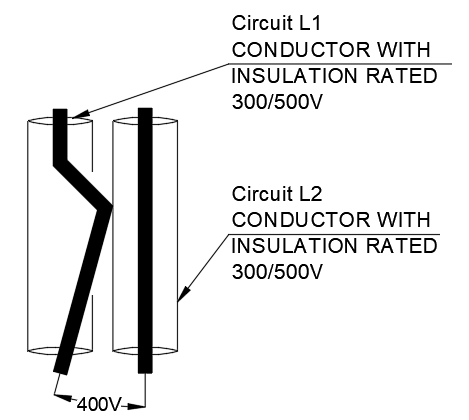concerning 300/500V cables complying to IEC 60227-4, installed in 3phase system 230/400V, I know that it is acceptable to be installed as per IEC 62440-2008 table 2.(which allows it for up to 320/550V system).
Actually my question is related grouped circuits in same cable tray, conduit , trunking or even panel boards enclosure, rather than the cable it self if it withstand the rated voltage.
Section 521.6 of BS 7671, states that " Two or more circuits are allowed in the same conduit, ducting or trunking system provided the requirements of Section 528 are met". Section 528.1 states that " Every cable or conductor is insulated for the highest voltage present". To comply with requirement one may say that in 230/400V 3-Phase system, each conductor of cables must be rated atleast U0/U=400/692 rather than U0/U=230/400V, and the reason consider we have 3x 1-Phase circuits grouped in same let's say DN50 Conduit, so if one of the conductors(say line L1) in the group had insulation failure, the other conductors (of lines L2 and L3) will be exposed to voltage between the conductor and its surrounding medium which is denoted by U0 of 400V rather than 230V. So here my question is what is the philosophy of section 521.6, which protection it's trying to provide? or shall we use higher rated cables in order to comply? if we must use higher rated cables in case of different circuit, then I think it has some meaning to also mandate using higher rating in case of conductors of same 3-phase circuit (knowing that IEC 62440-2008 table 2 allows 300/500V cables to be installed for 230/400V 3-phase system).
Note overall sheath is not taken into consideration as a mean of protection in this section as it is usually doesn't contribute in the voltage rating of cable.


